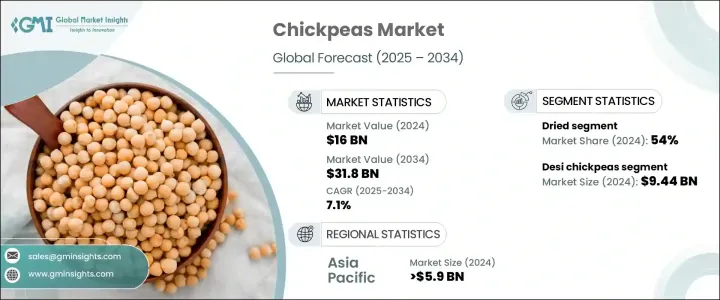
|
시장보고서
상품코드
1685127
병아리콩 시장 기회, 성장 촉진요인, 산업 동향 분석, 예측(2025-2034년)Chickpeas Market Opportunity, Growth Drivers, Industry Trend Analysis, and Forecast 2025 - 2034 |
||||||
세계의 병아리콩 시장은 2024년에 160억 달러로 평가되었으며, 2025년부터 2034년까지의 CAGR은 7.1%를 나타내 현저한 성장이 예측되고 있습니다.
이 눈부신 성장은 영양가가 높은 식물성 단백질의 대체품에 대한 수요 증가와 더 건강한 식습관으로의 전환으로 인한 것입니다. 병아리콩은 전 세계의 다양한 요리에 필수적인 재료이며 고 단백질,식이 섬유, 비타민, 미네랄을 포함하는 것으로 알려져 있습니다. 채식주의자, 비건, 플렉시탈리안과 같은 식생활을 섭취하는 사람들이 늘어남에 따라 병아리콩은 그들의 주식이되고 있습니다. 병아리콩 소비와 관련된 건강상의 이점에 대한 인식이 높아짐에 따라 시장 성장이 더욱 강화되고 있습니다. 게다가 글루텐 프리나 비유전자변형 식품의 인기가 높아지고 있는 것도 수요를 뒷받침하고 있습니다. 병아리콩은 천연 글루텐 자유로운 유전자 변형이 아니기 때문에 건강 지향 소비자에게 매력적인 선택입니다.

최근, 식물성 단백질에의 소비자 변화가 진행되고 있어, 병아리콩은 가장 주목받고 있는 식재료의 하나가 되고 있습니다. 볼륨있는 카레에서 영양가 높은 샐러드까지 다양한 요리에 사용할 수 있는 범용성의 높이에서 현대인의 식생활에 빠뜨릴 수없는 재료가되고 있습니다. 또한 병아리콩은 가공을 최소화한 통 식품을 중시하는 클린 이팅의 동향 중에서도 기세를 늘리고 있습니다. 동물성 단백질에 비해 이산화탄소 배출량이 적은 등 식물성 단백질의 환경면에서의 이점에 대한 의식의 고조도 수요 급증의 원인이 되고 있습니다. 식품 선택에 지속가능성을 선호하는 사람이 늘어나는 가운데 병아리콩은 보다 친환경적인 대체품으로 간주되어 이 시장에 새로운 매력을 더하고 있습니다.
| 시장 범위 | |
|---|---|
| 시작 연도 | 2024년 |
| 예측 연도 | 2025-2034년 |
| 시작 금액 | 160억 달러 |
| 예측 금액 | 318억 달러 |
| CAGR | 7.1% |
다양한 병아리콩 제품 유형 중에서 데시 병아리콩 부문은 2024년에 94억 4,000만 달러를 생산했습니다. 크기가 작고 외피가 거칠고 맛이 강한 것으로 알려진 데시산 병아리콩은 주로 남아시아 요리에서 사용됩니다. 카레와 스튜와 같은 전통 요리의 요리에 필수적이며 세계의 다양한 요리 용도에 사용되는 주식인 베산(병아리콩가루)의 주요 원료이기도 합니다. 이 부문의 이점은 이 지역에서 병아리콩의 문화적 중요성을 반영하여 가정 요리와 산업 식품 생산 모두에 적합합니다.
형태에 관해서는 건조 병아리콩이 2024년에 54% 시장 점유율을 차지했지만, 이것은 주로 그 범용성과 긴 보존 기간에 의한 것이었습니다. 이 병아리콩은 가정과 외식 산업에서 선호되며 전통적인 조리법부터 현대적인 건강 지향식에 이르기까지 다양한 요리에 사용할 수 있습니다. 그 편리함과 편리함으로, 세계의 많은 주방에서 빼놓을 수 없는 재료가 되고 있습니다.
아시아태평양은 세계의 병아리콩 시장을 선도했으며 2024년 시장 규모는 59억 달러였습니다. 중국에서만 46억 달러를 차지하며 인도, 파키스탄, 호주 등 국가들이 이 지역 시장에 크게 기여하고 있습니다. 특히 인도는 병아리콩의 주요 생산국·소비국이며, 많은 전통요리의 기초가 되고 있습니다. 이 지역의 채식 인구가 많고 식물성 식품에 대한 문화적 의존이 병아리콩 수요를 계속 견인하고 있으며,이 지역 시장은 계속 견조합니다. 식물 기반 식생활의 인기가 계속 증가함에 따라 아시아태평양은 앞으로도 병아리콩 시장의 주요 촉진요인이 될 것으로 예상됩니다.
목차
제1장 조사 방법과 조사 범위
- 시장 범위와 정의
- 기본 추정과 계산
- 예측 계산
- 데이터 소스
제2장 주요 요약
제3장 업계 인사이트
- 생태계 분석
- 밸류체인에 영향을 주는 요인
- 이익률 분석
- 파괴적 혁신
- 향후 전망
- 제조업체
- 유통업체
- 공급업체 상황
- 이익률 분석
- 주요 뉴스와 대처
- 규제 상황
- 영향요인
- 성장 촉진요인
- 식물성 식생활의 인기 증가
- 건강 지향 증가
- 업계의 잠재적 위험 및 과제
- 가격 변동
- 대체 단백질원과의 경쟁
- 성장 촉진요인
- 성장 가능성 분석
- Porter's Five Forces 분석
- PESTEL 분석
제4장 경쟁 구도
- 서론
- 기업 점유율 분석
- 경쟁 포지셔닝 매트릭스
- 전략 전망 매트릭스
제5장 시장 규모와 예측 : 제품 유형별(2021-2034년)
- 주요 동향
- 데시 병아리콩
- 카불 병아리콩
제6장 시장 규모와 예측 : 형태별(2021-2034년)
- 주요 동향
- 건조
- 가루 및 분말
- 캔
제7장 시장 규모와 예측 : 판매 채널별(2021-2034년)
- 주요 동향
- 슈퍼마켓/대형마트
- 편의점
- 온라인 소매
- 기타
제8장 시장 규모와 예측 : 용도별(2021-2034년)
- 주요 동향
- 식음료
- 동물 사료
- 건강기능식품
- 기타
제9장 시장 규모와 예측 : 지역별(2021-2034년)
- 주요 동향
- 북미
- 미국
- 캐나다
- 유럽
- 영국
- 독일
- 프랑스
- 이탈리아
- 스페인
- 러시아
- 아시아태평양
- 중국
- 인도
- 일본
- 한국
- 호주
- 라틴아메리카
- 브라질
- 멕시코
- 중동 및 아프리카
- 남아프리카
- 사우디아라비아
- 아랍에미리트(UAE)
제10장 기업 프로파일
- Abbott Blackstone
- Adascan Grain
- Agrana Group
- AGT Food and Ingredients
- Archer Daniel Midland(ADM) Company
- Ardent Mills
- ATC Group India
- Bean Growers Australia
- BroadGrain Commodities
- Cargill
- Cono Group
- Olam Agri
- OLEGA SA
- Roland Foods
- The Wimmera Grain Company
The Global Chickpeas Market was valued at USD 16 billion in 2024 and is projected to experience significant growth, with an estimated CAGR of over 7.1% from 2025 to 2034. This impressive growth is attributed to the increasing demand for nutritious, plant-based protein alternatives and a shift towards healthier eating habits. Chickpeas are an essential part of various cuisines worldwide, known for their high protein content, fiber, vitamins, and minerals. As more people embrace vegetarian, vegan, and flexitarian diets, chickpeas are becoming a staple in their food choices. The growing awareness of the health benefits linked to chickpea consumption is further boosting market growth. Additionally, the rising popularity of gluten-free and non-GMO food products is fueling demand, as chickpeas are naturally gluten-free and non-genetically modified, making them an attractive option for health-conscious consumers.

In recent years, there has been an increasing consumer shift towards plant-based proteins, and chickpeas have emerged as one of the most sought-after ingredients. Their versatility in various dishes-from hearty curries to nutritious salads-has made them a key component in modern diets. Furthermore, chickpeas have gained momentum in the growing trend of clean eating, with an emphasis on whole, minimally processed foods. The growing awareness about the environmental benefits of plant-based proteins, such as a lower carbon footprint compared to animal-based proteins, has also contributed to the surge in demand. With more people prioritizing sustainability in their food choices, chickpeas are seen as a more eco-friendly alternative, adding another layer of appeal to this market.
| Market Scope | |
|---|---|
| Start Year | 2024 |
| Forecast Year | 2025-2034 |
| Start Value | $16 Billion |
| Forecast Value | $31.8 Billion |
| CAGR | 7.1% |
Among the various chickpea product types, the desi chickpeas segment generated USD 9.44 billion in 2024. Known for their small size, rough outer coat, and stronger flavor, desi chickpeas are predominantly used in South Asian cuisines. They are integral to the preparation of traditional dishes such as curries and stews and are also a key ingredient in besan (chickpea flour), a staple used in a variety of culinary applications across the globe. This segment's dominance is a reflection of the cultural importance of chickpeas in these regions, as well as their suitability for both home cooking and industrial food production.
When it comes to form, dried chickpeas held a 54% market share in 2024, largely due to their versatility and long shelf life. These chickpeas are favored in households and the food service industry, where they can be used in a wide array of dishes, from traditional recipes to contemporary health-conscious meals. Their convenience and extended usability have made them a go-to ingredient in many kitchens worldwide.
The Asia Pacific region led the global chickpeas market, valued at USD 5.9 billion in 2024. China alone accounted for USD 4.6 billion, with countries like India, Pakistan, and Australia contributing significantly to the regional market. India, in particular, stands as a major producer and consumer of chickpeas, where it is a cornerstone of many traditional dishes. The region's large vegetarian population and the cultural reliance on plant-based foods continue to drive the demand for chickpeas, ensuring that the market remains robust in this part of the world. As the popularity of plant-based diets continues to rise, Asia Pacific is expected to remain a key growth driver for the chickpeas market in the coming years.
Table of Contents
Chapter 1 Methodology & Scope
- 1.1 Market scope & definition
- 1.2 Base estimates & calculations
- 1.3 Forecast calculation
- 1.4 Data sources
- 1.4.1 Primary
- 1.4.2 Secondary
- 1.4.2.1 Paid sources
- 1.4.2.2 Public sources
Chapter 2 Executive Summary
- 2.1 Industry synopsis, 2021-2034
Chapter 3 Industry Insights
- 3.1 Industry ecosystem analysis
- 3.1.1 Factor affecting the value chain
- 3.1.2 Profit margin analysis
- 3.1.3 Disruptions
- 3.1.4 Future outlook
- 3.1.5 Manufacturers
- 3.1.6 Distributors
- 3.2 Supplier landscape
- 3.3 Profit margin analysis
- 3.4 Key news & initiatives
- 3.5 Regulatory landscape
- 3.6 Impact forces
- 3.6.1 Growth drivers
- 3.6.1.1 Increasing popularity of plant-based diets
- 3.6.1.2 Increasing Health Consciousness
- 3.6.2 Industry pitfalls & challenges
- 3.6.2.1 Price volatility
- 3.6.2.2 Competition from alternative protein sources
- 3.6.1 Growth drivers
- 3.7 Growth potential analysis
- 3.8 Porter’s analysis
- 3.9 PESTEL analysis
Chapter 4 Competitive Landscape, 2024
- 4.1 Introduction
- 4.2 Company market share analysis
- 4.3 Competitive positioning matrix
- 4.4 Strategic outlook matrix
Chapter 5 Market Size and Forecast, By Product Type, 2021-2034 (USD Billion) (Kilo Tons)
- 5.1 Key trends
- 5.2 Desi chickpeas
- 5.3 Kabuli chickpeas
Chapter 6 Market Size and Forecast, By Form, 2021-2034 (USD Billion) (Kilo Tons)
- 6.1 Key trends
- 6.2 Dried
- 6.3 Flour & Powder
- 6.4 Canned
Chapter 7 Market Size and Forecast, By Sales Channel, 2021-2034 (USD Billion) (Kilo Tons)
- 7.1 Key trends
- 7.2 Supermarkets and Hypermarkets
- 7.3 Convenience stores
- 7.4 Online retail
- 7.5 Others
Chapter 8 Market Size and Forecast, By Application, 2021-2034 (USD Billion) (Kilo Tons)
- 8.1 Key trends
- 8.2 Food & Beverages
- 8.3 Animal feed
- 8.4 Nutraceuticals
- 8.5 Other
Chapter 9 Market Size and Forecast, By Region, 2021-2034 (USD Billion) (Kilo Tons)
- 9.1 Key trends
- 9.2 North America
- 9.2.1 U.S.
- 9.2.2 Canada
- 9.3 Europe
- 9.3.1 UK
- 9.3.2 Germany
- 9.3.3 France
- 9.3.4 Italy
- 9.3.5 Spain
- 9.3.6 Russia
- 9.4 Asia Pacific
- 9.4.1 China
- 9.4.2 India
- 9.4.3 Japan
- 9.4.4 South Korea
- 9.4.5 Australia
- 9.5 Latin America
- 9.5.1 Brazil
- 9.5.2 Mexico
- 9.6 MEA
- 9.6.1 South Africa
- 9.6.2 Saudi Arabia
- 9.6.3 UAE
Chapter 10 Company Profiles
- 10.1 Abbott Blackstone
- 10.2 Adascan Grain
- 10.3 Agrana Group
- 10.4 AGT Food and Ingredients
- 10.5 Archer Daniel Midland (ADM) Company
- 10.6 Ardent Mills
- 10.7 ATC Group India
- 10.8 Bean Growers Australia
- 10.9 BroadGrain Commodities
- 10.10 Cargill
- 10.11 Cono Group
- 10.12 Olam Agri
- 10.13 OLEGA S.A.
- 10.14 Roland Foods
- 10.15 The Wimmera Grain Company



















